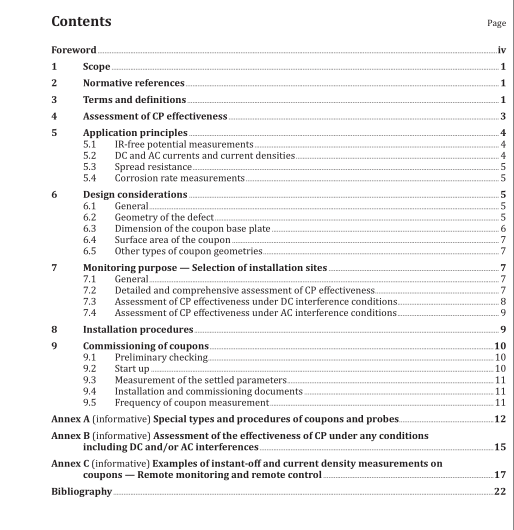ISO 22426:2020 pdf download.Assessment of the effectiveness of cathodic protection based on coupon measurements
4 Assessment of CP effectiveness
The assessment of the effectiveness of CP in accordance with ISO 15589-1 is based on an IR-free potential measurement. The determination of the IR-free potential on the cathodically protected structure is only possible based on combined direct current voltage gradient and close-interval potential survey measurements. This method is called “intensive measurement” and is described in EN 13509. This method requires, however, significant measurable voltage gradients associated with individual coating defects in order to allow for a reliable assessment of their IR-free potential and demonstrating conformity to ISO 15589-1. As a consequence, the determination of IR-free potential and demonstrating conformity to ISO 15589-1 is no longer possible on today’s structures with high-quality coating systems. While it is still possible to determine instant-off potentials on many structures and use this reading as an approximation to the IR-free potential in certain cases, the increasing level of AC interference is preventing the separation of the earthing systems connected through decoupling devices from the cathodically protected structures for safety reasons. Similarly, in the presence of DC interference conditions, the determination of both IR-free potentials and instant-off potentials is not possible. As a consequence, on an increasing number of structures neither IR-free potentials nor instant-off potentials can be determined in order to demonstrate conformity to ISO 15589-1. The only remaining technology for demonstrating effectiveness is the use of coupons that are connected to the structure under investigation. The use of coupons is further required by ISO 18086. The determination of the effectiveness of CP under AC interference is only possible based on a current density measuremen on coupons. The validity and accuracy of data obtained on coupons depend on a number of factors, such as location, geometry and bedding conditions. This document provides guidance on these aspects.
5 Application principles
5.1 IR-free potential measurements
The traditional coupon measurement technique has been used to demonstrate conformity of the coupon polarization, which is taken to be representative of the structure coating defects in accordance with the requirements of ISO 15589-1. There are several situations where the use of coupons is a feasible alternative to IR-free potential measurements directly on the structure. In particular, when accurate measurements directly on the structure itself are problematic. Examples include:
— in areas affected by traction stray currents and telluric currents;
— when dealing with the CP of complex structures;
— interference caused by two or more cathodically protected structures crossing or sharing the same right-of-way;
— interference between both parts of an isolating joint for a structure protected by two different CP systems one on each side of the joint;
— effects from equalizing currents from adjacent coating defects: the coupon may be regarded as one single coating defect exposed in the chemistry of the soil exactly where the coupon has been buried, whereas measurements on the structure may include a range of coating defects exposed in varying individual soil chemistries leading to the formation of potential differences and varying current demand;
— in areas where the CP is applied using several CP sources, and it is not possible or economically practical to synchronously turn off these CP sources.
EN 13509, EN 50162, ISO 18086 and ISO 15589-1 allow for the use of coupons in such instances.
5.2 DC and AC currents and current densities
The use of coupons allows for an assessment of current densities in order to demonstrate conformity to ISO 18086 and EN 50162.
The DC current consumed by a coupon is primarily used for assessing the significance of DC stray current interference. EN 50162 describes a procedure for the demonstration of effectiveness of CP based on current density. This involves measuring the DC current throughout a period of typically 24 h. From these measurements, a period is defined in which no interference is present (e.g. hours during the night when trains do not operate). This period is used as the reference value and the measure of the reference current under normal CP. Based on the analysis of these currents, an assessment of the effectiveness of CP under DC interference is performed.ISO 22426 pdf download.ISO 22426 pdf download
